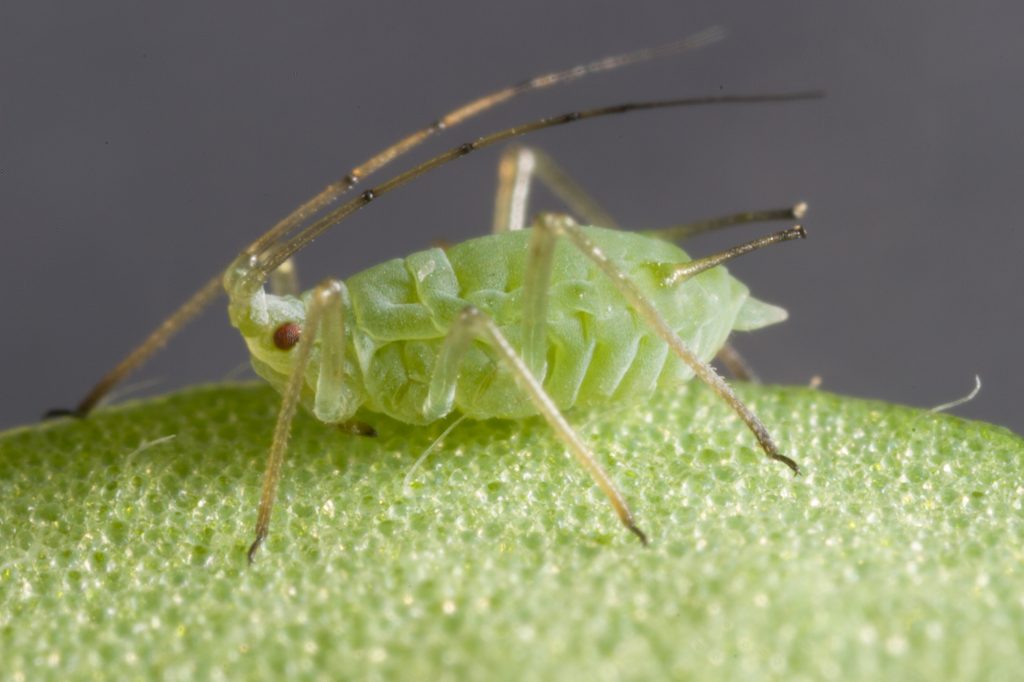Bluegreen aphids can be difficult to control because they can quickly build up in large numbers and they avoid sprays by hiding deep within the crop. We have had reports of chemical control failures against this aphid across south eastern cropping regions recently.
In this article we cover spray considerations, possible reasons for why a spray may not achieve the expected result and request on the ground information regarding any recent chemical control failures.
Bluegreen aphids and control issues
Bluegreen aphids are grey-green to blue-green coloured phloem-feeding insects that are common across Australia in spring but are also active in autumn and winter. They can attack lupins, lucerne, medics and clovers, with heavy infestations causing plants to wilt and become yellow.
More information on bluegreen aphids can be found in our Pestnotes article
Aphids are known to readily evolve insecticide resistance, at least in part because of their asexual mode of reproduction which allows the female to pass on all her genes to her offspring (ie. if the mother is resistant, all offspring will be too).
We are currently working to identify any instances of decreased sensitivity of aphids to insecticides. Over the last few years, we have been made aware of multiple control failures following the application of organophosphates to control bluegreen aphids.

Spray application considerations
There are several insecticides registered against bluegreen aphids in legume and pulse crops, but they should only be used if necessary, according to available thresholds. When required, good practice management includes rotating between different chemical groups and avoiding routine broad-spectrum sprays.
If the crop is thought to be at risk from aphid infestation, due to the paddock history or weather conditions for instance, a border spray in autumn/early winter, when aphids begin to move into crops, may provide sufficient control without the need to spray the entire paddock.
Using the appropriate water volume and droplet size will also ensure optimum spray coverage in order to maximise contact with aphids hiding within crop.
For example, medium, rather than large, droplet sizes have been found to be more effective against aphids and a review from CSIRO recommends against using misters as the droplet sizes are too small.
High spray volumes using hollow or flat fan nozzles are recommended because aphids are able to shelter in the mid canopy of most crops. In a crop with narrow rows, a lower application volume may result in less penetration of the canopy. Adding a wetter to some sprays can also help the insecticide penetrate the aphid’s waxy surface.
For more information on nozzle selection see the GRDC back pocket guide
Indications of control failure
A control failure has occurred when application of an insecticide does not have the intended suppressive effect on a target pest population.
It is important to be on the lookout for evidence of control failures because they can be an early indicator of insecticide resistance evolution.
Reasons for large numbers of pests after spraying could be:
- The spray did not reach all individuals
- Pest populations from outside have immigrated into the paddock from elsewhere soon after the spray was applied
- The chemical reached the pests, but did not provide adequate control.
This last point could indicate the presence of resistant individuals. However, situations such as this need to investigated thoroughly as there may be other reasons that may be the cause for this effect, such as incorrect pest identification, incorrect pesticide concentration, or incorrect timing (e.g. the pest was not in the area or a life stage was targeted that is not susceptible to insecticide).
Report bluegreen aphid control failures
Cesar Australia and CSIRO are working to track chemical sensitivity shifts that might exist among bluegreen aphid populations so that we can help develop long-term control measures and avoid future issues with resistance.
If you have observed a control failure after attempting to manage a population of bluegreen aphid please get in touch with us. We would be keen to talk about the conditions under which you experienced a control failure and may ask for a sample of the aphids to test.
Acknowledgements
Thanks to Dr Paul Umina, Leo McGrane and Dr Jessica Lye for assisting with the development of this article.
Cover image: Photo by Andrew Weeks, Cesar Australia





